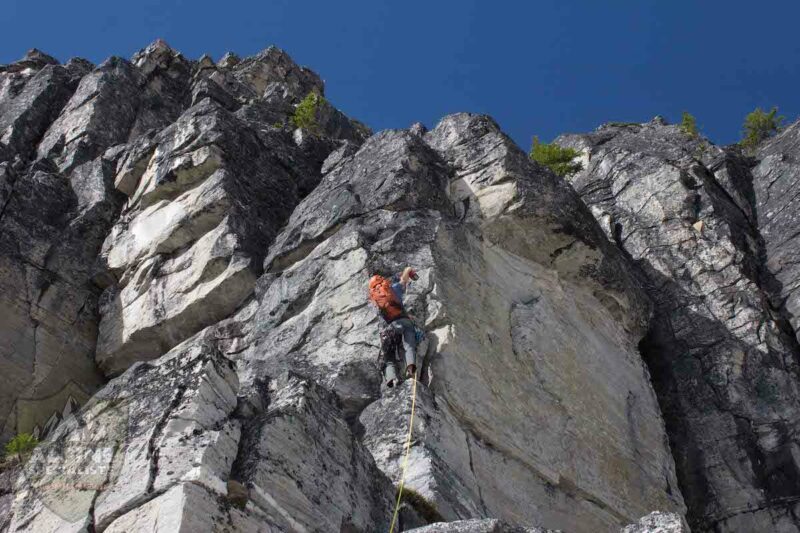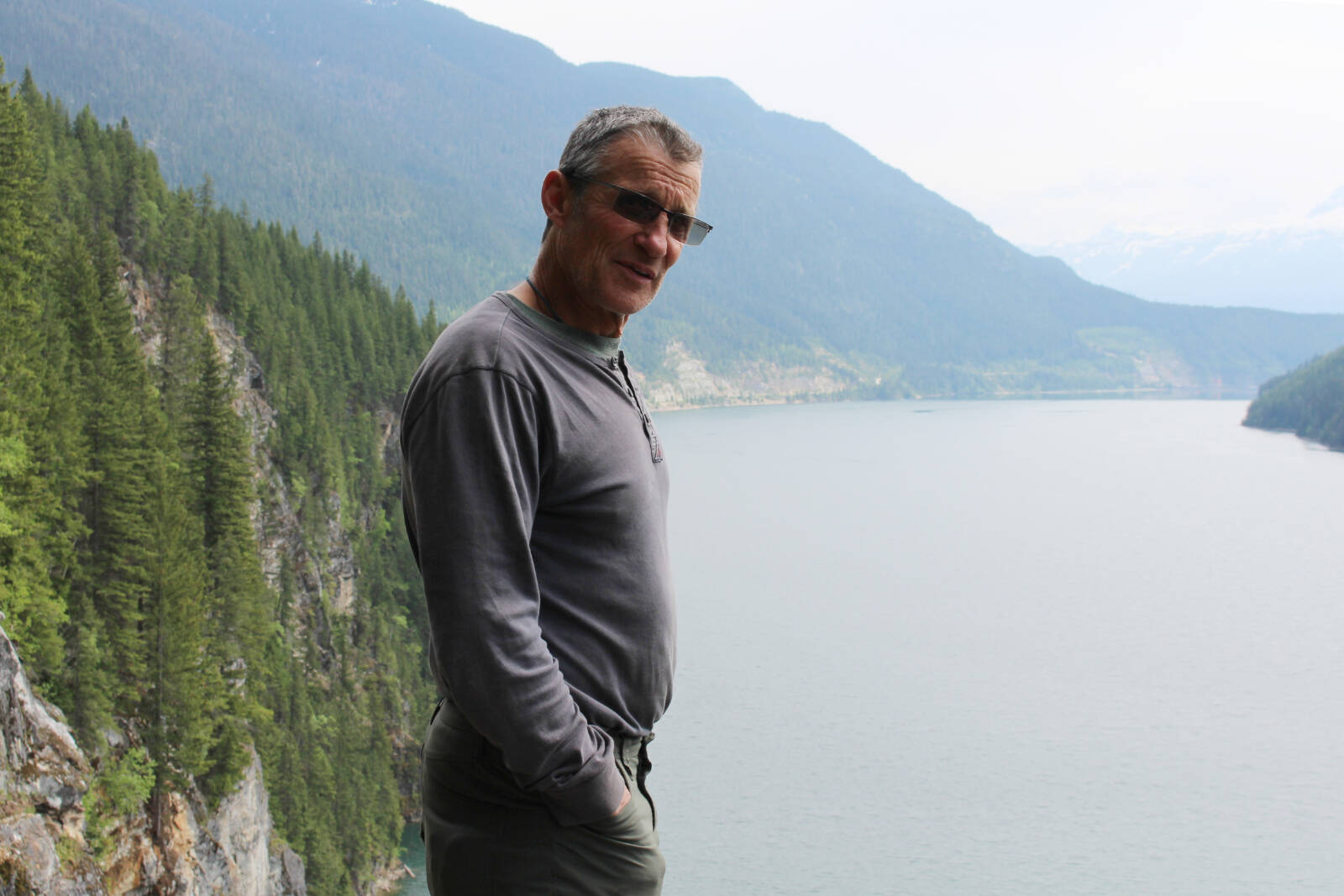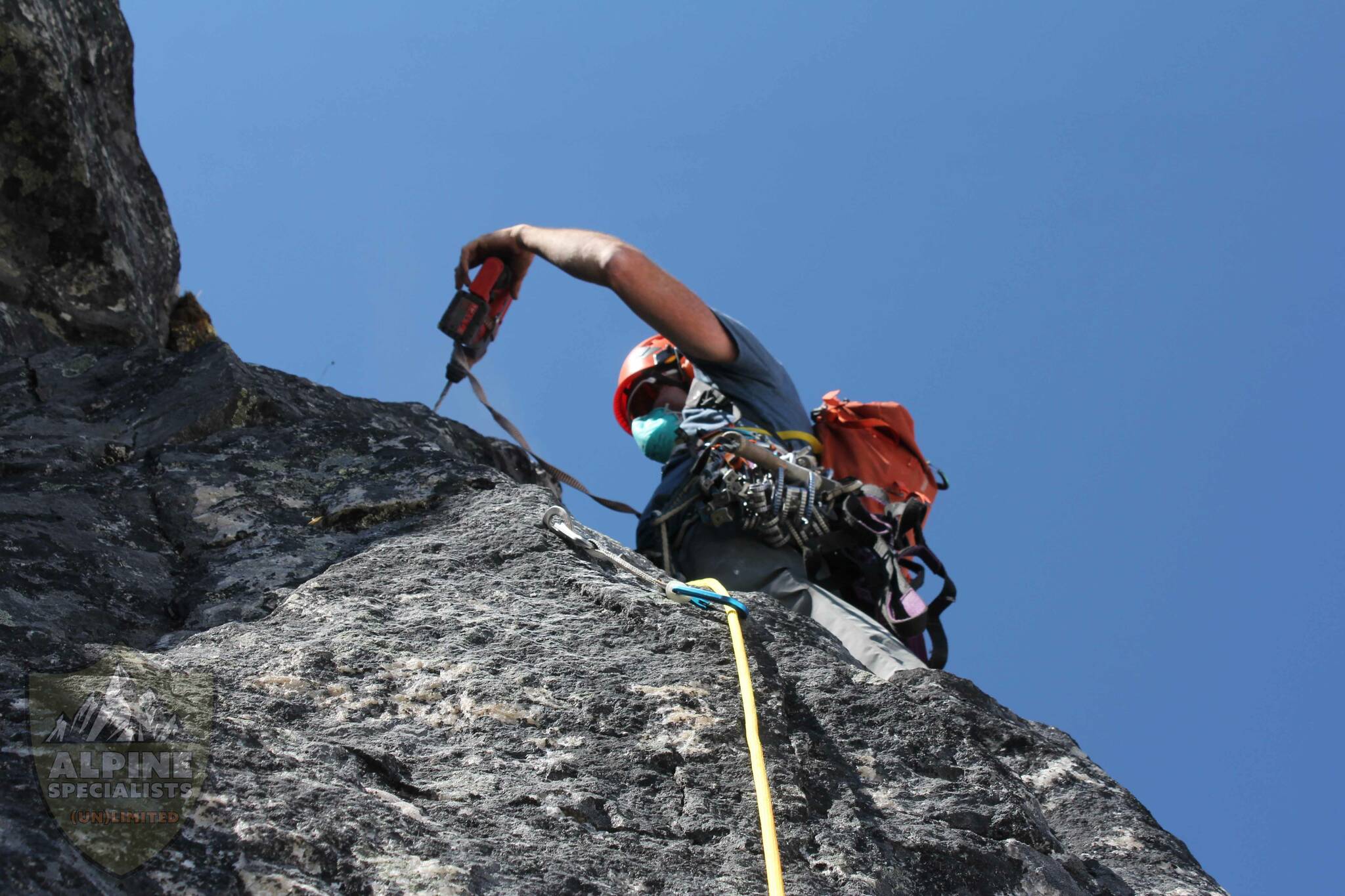Revelstoke’s reputation as a snowsports hub is well-known around the world, but it’s also growing into an established rock-climbing destination, offering locals and visitors alike their pick of walls, crags and routes around town.
So, how do you get started? You look for experience, you look for recognition, you look for the person who (literally) wrote the book on it. This was how I first heard about Ruedi Beglinger.
“I’ve been climbing since I arrived here in the early ‘80s,” says Beglinger, who grew up in the Swiss Alps and has amassed a life of outdoor experience. His business, Selkirk Mountain Experience, offers hiking, mountaineering and skiing tours.
Before arriving in Revelstoke, Beglinger climbed in several areas across Europe, Yosemite National Park, Squamish and the Bow Valley. When he got to Revelstoke, there wasn’t much climbing to speak of, he says.
“We saw the potential and so in the early ‘90s we started to build actual sport routes,” Beglinger says.
READ MORE: Mount Rainier named best mountain climbing destination in U.S.
As they built the routes, Beglinger started working on a guidebook, Revelstoke Rocks – now the ultimate resource for climbing in Revelstoke. Putting the book together was a feat of determination and a testament to teamwork. Beglinger worked hard to get the most information he could about every zone, pitch and approach.
The book, now in its third edition, has information about all 18 climbing areas around Revelstoke, including more than 450 routes, and credit for their original developers.
Having a guidebook is vital to growing the sport. As such, Beglinger’s contributions to the local climbing community and its growth cannot be overstated. Between the book that helps more people access rock-climbing around Revelstoke, and the more than 40 routes that he’s developed, Beglinger is an ambassador to the sport.
As a local expert, I asked Beglinger about the news in Revelstoke’s climbing community. He spoke about a few different topics, but specifically highlighted the work of two individuals: Eric Dafoe and Cam Molder.
Eric Dafoe is a 72-year-old local climber and retiree. After a career in Rogers Pass working as a Park Warden for 20 years and Avalanche Control for 12, Dafoe was due for his choice of a relaxing retirement, but his service work in the outdoors continues.
“Well, it was a conscious choice,” Dafoe says of his ongoing work, while standing high above the cliffs of Waterworld, a climbing area he helped develop that overlooks Lake Revelstoke.
Dafoe has helped add a degree of professionalism to the climbing around Revelstoke. After helping develop a variety of routes with Beglinger, Dafoe has worked with the Revelstoke Climbing Access Society and Recreation Sites and Trails British Columbia to spruce up the staging areas.
“The areas were developed before I retired, and I decided to get involved with the Access Society and see if we can make some improvements,” he says.
Dafoe took me to the Big Eddy Boulders – a climbing area on Westside Road. The climbing locale has a parking lot, a sign outlining routes, a washroom, picnic tables and garbage cans, all the result of Dafoe’s work. When they first examined the area, it was filled with garbage. Dafoe explained that on days when the landfill was closed the space was often used as a dump site. He and a group of volunteers cleared out the space over a few days and many loads to the landfill.
The Big Eddy Boulder zone is just one example of the work Dafoe has done to legitimize climbing spaces.
READ MORE: ‘Craft gear from here:’ Kootenays eyed by wilderness lovers and entrepreneurs alike
Other examples can be found at any of the climbing sites with washrooms, which is also another job that Dafoe has taken on: cleaning washrooms.
“So far, I’ve done the majority of the toilet cleaning. And I’ve got the system down. I whine about it every now and again and I don’t plan to do it for the rest of my life, but when you get down to doing it, the task isn’t that hard,” he says.
Dafoe doesn’t do the work for recognition; he just wants the sites to be the best that they can be for the people who use them.
Still, he enjoys it when his work doesn’t go unnoticed.
“I certainly feel good every time somebody tells me they appreciate the work that I’ve been doing and what the Climbers Access Society has been doing,” he said.
When he isn’t applying for grants to pay for new recreation sites or cleaning rural washrooms, Dafoe still gets plenty of time climbing. He often climbs with Beglinger or Molder, and sometimes both. When climbing with Molder, the two often develop new routes or refurbish old ones.
Dr. Cam Molder works at the Selkirk Medical Group clinic in Revelstoke. He’s been in town since the early ‘90s, which is also when he started climbing more frequently. If Molder isn’t in the clinic, he can most likely be found by going to the nearest climbing zone and looking up.
He’s probably the one with goggles, a face mask, a hammer and a drill, and will likely be covered in a thick layer of dust.
Molder spoke about the work he was doing as he sat in the shade outside of his home after a day of climbing: “Just building new routes and redeveloping old ones that have sort of been abandoned or super old.”
A route needs to be redeveloped when it’s developed but not climbed frequently. The expression “a rolling rock gathers no moss,” is probably the best analogy to understand how it happens.
Routes are created by someone who liked the line, but then they moved on, moved away, or forgot about it. The longer the route sits untouched, the more moss gathers on the holds. With no one climbing, the foliage grows, covering the rock and providing more opportunity for moss to grow.
READ MORE: Taking love to new heights: A proposal in Revelstoke’s mountains
Molder, with Dafoe’s help, revisits climbing sites that need some love and fixes them up. Redeveloping the routes involves pulling old anchors that have rusted, clearing moss off holds, removing loose rocks and more. It’s an arduous process that Molder estimates takes about 12 hours per route to complete, over a few sessions.
“It’s a ton of time and hot, dusty work,” Molder says.
He was torn between two motivations for taking on the challenge of cleaning up old routes.
“I’m as self-interested as anyone, I want to go climb fun routes,” he says initially, but adds that the real satisfaction comes from seeing others enjoying areas he helped develop or fix.
Begbie Falls Wall is just one example.
“I go there and there’s people there all the time now, so that’s great. That’s the most gratifying thing, honestly, to go back and see people there,” he says.
Those people are indicative of the growth the Revelstoke climbing community has experienced.
“There was no visitors for rock climbing back then. But now we run into people from all over Western Canada and trying to find the routes looking at the guidebook,” Molder says.
Having climbed all over the world, Beglinger attributes part of the growth to Revelstoke’s ballooning reputation as an adventure hub. It also has a lot to do with what’s available to climb around Revelstoke – everything from easy to more challenging routes.
Regardless of what’s bringing the visitors, Molder predicts sport climbing will be the future of Revelstoke climbing.
“I think there’ll be a few new areas that’ll pop up. But hopefully the existing areas will be revitalized and become more popular,” he says.
This article was originally published in the Revelstoke TIMES Magazine.
Plan your adventures throughout the West Coast at westcoasttraveller.com and follow us on Facebook and Instagram @thewestcoasttraveller. And for the top West Coast Travel stories of the week delivered right to your inbox, sign up for our weekly Armchair Traveller newsletter!













 Bigger, better Big Four bridge connects hikers to majestic ice caves
Bigger, better Big Four bridge connects hikers to majestic ice caves